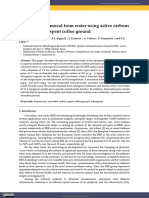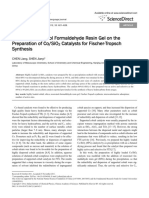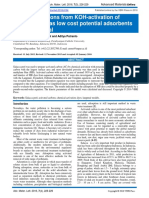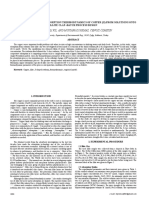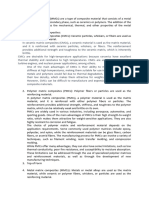Comparative Adsorption Capacity of Modified Activated Carbon From Pennisetum Glaucum and
Comparative Adsorption Capacity of Modified Activated Carbon From Pennisetum Glaucum and
Uploaded by
Praslita DishadewiCopyright:
Available Formats
Comparative Adsorption Capacity of Modified Activated Carbon From Pennisetum Glaucum and
Comparative Adsorption Capacity of Modified Activated Carbon From Pennisetum Glaucum and
Uploaded by
Praslita DishadewiOriginal Description:
Original Title
Copyright
Available Formats
Share this document
Did you find this document useful?
Is this content inappropriate?
Copyright:
Available Formats
Comparative Adsorption Capacity of Modified Activated Carbon From Pennisetum Glaucum and
Comparative Adsorption Capacity of Modified Activated Carbon From Pennisetum Glaucum and
Uploaded by
Praslita DishadewiCopyright:
Available Formats
International Journal of Scientific Engineering and Research (IJSER)
www.ijser.in
ISSN (Online): 2347-3878, Impact Factor (2015): 3.791
Comparative Adsorption Capacity of Modified
Activated Carbon from Pennisetum Glaucum and
Sorghum Bicolor.
O. A. Babatunde1, S. Garba2, Z. N. Ali3
1
Chemistry Department, Nigerian Defence Academy, Kaduna
mail4abiodun[at]yahoo.com
Chemistry Department, Nigerian Defence Academy, Kaduna
abubakarsaidu63[at]gmail.com
Applied Science Department, Kaduna Polytechnic, Kaduna
Jdanasabe[at]gmail.com
Abstract: The influence of surface modification of activated carbons prepared from straws of Pennisetum glaucum (millet)
and Sorghum bicolor (sorghum) with nitric acid and sodium hydroxide showed excellent improvement in their surface
characteristics. The effects of the oxidizing treatments on the surface area pore dimension and surface chemical characteristics were analyzed by means of iodine adsorption, Fourier Transform Infrared and Scanning Electron Microscopy analyses. Results obtained showed that modification with nitric acid increased the adsorptive capacity of the activated carbon
samples to a greater extent compared to sodium hydroxide.
Keywords: Pennisetun glaucum, Sorghum bicolor, surface chemical modification, adsorptive capacity
1. Introduction
activated carbon from low-cost agricultural by-products and
wastes such as straws offers an alternative source for acti-
The modification of the surface chemistry of activated car-
vated carbon. [20] prepared activated carbons from Sorghum
bon is considered an important and relevant technique used
and Millet straws by chemical activation; the carbons were
to alter the surface polarity and create functional groups on
used for adsorption of methylene blue and iodine from
the carbons surface in order to enhance its adsorptive capac-
aqueous solutions. The results obtained from their study
ity. The presence of functional groups such as the carboxyl,
showed that the activated carbons had high adsorptive capac-
carbonyl, phenols, lactones, quinines e.t.c. are usually consi-
ities. The utilization of these straws for production of acti-
dered to be responsible for the uptake of substances from
vated carbons to be used for adsorption of substances in ga-
gaseous streams or aqueous solutions [5]. These oxygen sur-
seous steams can also be investigated to ascertain their suita-
face complexes are formed on activated carbons when they
bility for gaseous and liquid phase adsorption. Iodine is
are treated with oxidizing agents in solution [13; 15] such as
usually used as test chemical to measure the capacity of an
nitric acid, tannic acid, citric acid, ammonia [18] or by micro
activated carbon to adsorb chemical compounds in liquid
wave, ozone and plasma treatment. The treatments usually
phase [12]. Iodine number (milligram iodine adsorbed per
produce three types of oxides, acidic, basic and neutral [15].
gram of activated carbon) is usually used to measure the po-
Fixation of the acidic groups on the surface of the activated
rosity of the activated carbon [10]. Each 1.0mg of iodine
carbons makes it more hydrophilic, removes mineral ele-
adsorbed is ideally considered to represent 1.0m2 of the acti-
ments present on the carbons surface and also affects the
vated carbons internal surface area [10].
surface area and pore texture of the activated carbons [16].
Base treatment of activated carbon produces positive surface
The focus of this paper was to study the influence of surface
charge which in turn is helpful towards adsorption of nega-
chemical modification of activated carbons prepared from
tively charged species in higher amounts [5]. Production of
two different precursors for adsorption of I2 from aqueous
Paper ID: 1071602
Volume 4 Issue 7, July 2016
Licensed Under Creative Commons Attribution CC BY
22 of 27
International Journal of Scientific Engineering and Research (IJSER)
www.ijser.in
ISSN (Online): 2347-3878, Impact Factor (2015): 3.791
solution.
2.2.2. Modification of Activated Carbon
2. Experimental
(a) Modification with Nitric Acid
2.1. Materials
To 10 g of the activated carbon sample, 100 cm3 of 2.0 M
nitric acid was added and soaked for 24 hrs. The residual
Millet and sorghum straws were obtained from Maguzawa
nitric acid was removed by soaking it in distilled water for 2
Farm in Rigasa Kaduna and were identified at the Herbarium
hrs and then washed several times with distilled water. The
section of the Herbarium Section of Biological Sciences
sample was then dried at 120 oC, cooled in a desiccator and
Department of Ahmadu Bello University Zaria Iodine
stored in plastic sample bottles.
(99.5 %), Potassium iodide (99.9 %), Sodium thiosulphate
(99.5 %), Potassium dichromate (99.5 %), Phosphoric acid
(b) Modification with Sodium hydroxide
(85 %) Nitric acid (69 %), Acetic acid (99.7 %) Ascorbic acid
(94.5 %), Hydrochloric acid (35.4 %), Sodium hydroxide
To 10 g of the activated carbon sample, 100 cm3 of 2.0 M
(99.0 %) Formic acid (90 %) and potassium hydroxide (90 %) sodium hydroxide was added and soaked for 24 hrs. The rewere all of analytical grade.
sidual sodium hydroxide was removed by soaking it in distilled water for 2 hrs and then washed several times with distilled water. The sample was then dried at 120 oC, cooled in a
2.2. Methods
desiccator and stored in plastic sample bottles.
2.2.1. Carbonization and Activation Process
2.2.3. Characterization of Activated carbon
Prior to carbonization, the millet and sorghum straws were
washed, dried, cut into pieces of approximately 3cm and then
The surface physical morphology of the unmodified and
pulverized to obtain particle sizes of about 1180m [14].The
modified activated carbons was observed using Phenom
activated carbon was then prepared by the two-step chemical
scanning electron microscope model proX and surface func-
activation process. The first step involves carbonization with
tional groups were identified using FTIR spectroscope (FTIR
60 % phosphoric acid solution and the second step involves
8400s, shimadzu) and the spectra recorded from 4000 to
activation using muffle furnace model SXL using and 1.0 M
500cm-1.
KOH at 600 oC for 1 hr [19]. The prepared activated carbon
was first washed with water containing 0.15 % formic acid
2.2.4. Iodine Number Test
and then washed severally with distilled water. They were
filtered through a Buchner funnel dried at 120 oC and then
The iodine number was determined according to the ASTM
weighed to determine the activated carbon yield. It was then
D4607-94 method [4] is based upon a three-point isotherm. A
stored in plastic sample bottles to prevent adsorption of dust
0.1 M standard iodine solution was added to three different
and other particles from the atmosphere.
weights of activated carbon samples in three 250 cm3 conical
flasks. The experiment involved treating the activated carbon
sample with 10.0 cm3 of 5 % HCl. This mixture was boiled
The activated carbon yield was calculated using Eq. 1
for 30 seconds and then cooled soon afterwards, 100 cm3 of
Yield % =
100
(1)
0.1 M iodine solution was added to the mixture and stirred
for 30 seconds. The resulting solution was filtered and 50.0
Where Wa is the weight of activated carbon and Wp is the
cm3 of the filtrate was titrated with 0.1 M sodium thiosul-
weight of precursor.
phate using starch solution as indicator. The amount of iodine
adsorbed per gram of carbon (iodine number) and the residual iodine concentration in the filtrate were calculated using
Eq 2.
IN =
Paper ID: 1071602
Volume 4 Issue 7, July 2016
Licensed Under Creative Commons Attribution CC BY
(2)
23 of 27
International Journal of Scientific Engineering and Research (IJSER)
www.ijser.in
ISSN (Online): 2347-3878, Impact Factor (2015): 3.791
Where IN is the iodine number, VB is the volume of Na2S2O3
used for blank titration, VS is the volume of Na2S2O3 used for
(6)
test titration, M1 is molarity of iodine solution, V1 is volume
of iodine solution used and W is weight of activated carbon.
The Freundich Isotherm model represented by Eq. 7 de2.2.5. Batch Adsorption Experiment and Adsorption Iso-
scribes the heterogeneous surface energies by multilayer ad-
therm of I2
sorption [7].
Batch Adsorption experiments were carried out to determine
(7)
the optimum contact time and adsorption isotherms of I2 onto
the activated carbon in a series of 250 mL conical flasks. The
procedure involved filling each flask with 100 cm3 of 0.1 M
Freundich Isotherm when expressed in the logarithmic form;
iodine solution. Equal weights of activated carbon were add-
the empirical equation becomes a straight line and the con-
ed into the different flasks and the flasks were shaken using
the Griffin flask shaker to achieve equilibrium. The adsorp-
are found by linear regression.
stants KF and
tion isotherm for I2 were studied by varying the activated
carbon weights between 0.4 to 2.4 g at a concentration of 0.1
M iodine solution and for an optimal period of 1 hr, while the
Log qe = log KF +
log Ce
(8)
effect of contact time was studied at different time periods of
10, 20, 30, 60, 90 and 120 minutes.
3. Results and Discussion
2.2.6. Adsorption Isotherm Models
3.1. Characterization of Unmodified and Modified Activated Carbons
The Langmuir and Freundlich isotherms models were employed to determine the relationship between the amount of
The FTIR spectra of the unmodified activated carbons present
I2 uptake (qe) and its concentration at equilibrium (Ce)
broad and intense peak of O-H stretching vibrating of hydroxyl groups of alcohols, phenols or absorbed water at
The amount of I2 adsorbed per gram of carbon was calculated
3414.12 & 3444.98 cm-1 for the millet and sorghum straws
using Eq 3
respectively. The bands were found to be slightly shifted in the
modified samples at 3472.95 and 3390.97 cm-1 respectively.
(3)
The bands at 1644.37 & 1640.51 cm-1 due to C=C stretching
Where C1 and Ce are the initial and equilibrium concentration
vibration in alkenes observed in the unmodified samples, were
(mg/L), M is the mass of activated carbon (g) and V is the
found to occur at 1642.44 & 1643.41 cm-1 for the modified
volume of the solution (mL). Percent I2 removal was calcu-
samples. The bands in the region of 1378.18 & 1385.90 cm-1
lated using Eq. 4
that are due to the stretching vibration of the nitro group
(C-NO2) [8], were only detected in the modified samples.
Other bands detected are 1138.04 & 1146.72 cm-1 in the un(4)
modified samples due to C-O stretching vibration in alcohols
The Langmuir model which assumes monolayer adsorption
or ether but were found at 1160.22 & 1146.01 cm-1 in the
onto the activated carbon is given by Eq. 5
modified samples.
The SEM micrographs of the activated carbons are shown in
(5)
This when manipulated to the linear form gives Eq. 6
Figures 1 a-f more open structures are exhibited in the modified activated carbon samples than the unmodified activated
carbons, caused by the collapse of the micropores and creation
of macropores which may be due to the introduction of oxy-
Paper ID: 1071602
Volume 4 Issue 7, July 2016
Licensed Under Creative Commons Attribution CC BY
24 of 27
International Journal of Scientific Engineering and Research (IJSER)
www.ijser.in
ISSN (Online): 2347-3878, Impact Factor (2015): 3.791
gen containing functional groups from the modifying agents.
sorption of cadmium ions from aqueous solution. The adsorption of Perchlorate (ClO4-) from aqueous solution was
examined with ammonia treated activated carbon by [6]; the
researchers noted that higher adsorption capacity for perchlorate was achieved without undermining the pore structure.
3.3. Effect of Contact Time
The effect of contact time on I2 adsorption efficiency using the
modified activated carbons showed that about 80 % of I2 was
absorbed by millet straw activated carbon while 72 % of I2 was
absorbed by sorghum straw activated carbon within 1 hr,
while about 89 % of I2 was absorbed by millet straw and 77 %
of I2 was observed by sorghum straw after 2 hrs.
Figure 1: SEM images of (a) unmodified millet straw acti-
Figure 2: The percent iodine adsorbed against contact time
vated carbon, (b) unmodified sorghum straw activated carbon,
by unmodified millet straw activated carbon and the various
(c) nitric acid modified millet straw activated carbon, (d) nitric
modified millet straw activated carbon (2.0 M HNO3 and 2.0
acid modified sorghum straw activated carbon, (e) sodium
M NaOH) using 1.0 M KOH at 600 oC
hydroxide modified millet straw activated carbon and (f)
sodium hydroxide modified sorghum straw activated carbon
3.2. Iodine number
Table 1 showed that the iodine numbers of the unmodified
activated carbons (UMS and USS) were 689.3mg/g and
565.4mg/g, and after modification with nitric acid and sodium
hydroxide higher iodine number values were obtained as
presented in Table 1. Between the two modifying agents used
nitric acid improves the pore structure and surface area of the
Figure 3: The percent iodine adsorbed against contact time
activated carbons more there by leading to enhanced adsorp-
by unmodified sorghum straw activated carbon and the vari-
tive capacity. Similar results were obtained by other re-
ous modified sorghum straw activated carbon (2.0 M HNO3
searchers; [1] observed that the adsorption of Cr (III) was
and 2.0 M NaOH) using 1.0 M KOH at 600 oC
increased on oxidation of granular activated carbons with
nitric acid, hydrogen peroxide and ammonium persulphate in
3.4. Adsorption Isotherms
aqueous solution. Another report [11] showed that the incorporation of acidic oxygen functional groups into activated
Table 2 represents the Langmuir and Freundlich isotherm
carbon by HNO3 oxidation dramatically enhanced the ad-
parameters for adsorption of iodine. It was found that the
Paper ID: 1071602
Volume 4 Issue 7, July 2016
Licensed Under Creative Commons Attribution CC BY
25 of 27
International Journal of Scientific Engineering and Research (IJSER)
www.ijser.in
ISSN (Online): 2347-3878, Impact Factor (2015): 3.791
equilibrium data were fitted into both isotherm models with R2
4. Conclusion
of the modified activated carbons being higher (0.964, 0.973)
than those of the unmodified activated carbons (0.759, 0.828).
The present study highlighted the importance and relevance
of chemical modification of the surface chemistry of acti-
KF and , indicated normal adsorption [9] and the maximum
vated carbon produced from Pennisetum glaucum and Sorghum bicolor. SEM images and FTIR analysis showed in-
monolayer coverage (Qo) was also found to be generally
creased pore formation and increase in the number of surface
higher in the modified activated carbons (50.0 mg/g and 47.62
functional groups as a result of the modification treatment. A
mg/g) compared to the unmodified activated carbons (2.976
significant increase in iodine number was achieved after
mg/g and 3.311 mg/g).The equilibrium parameter (RL) was
modification, but the best results was obtained for the nitric
found to be greater than zero but less than 1 indicating that all
acid modified activated carbon samples; between the two
the adsorption processes were favourable [17].
precursors studied, nitric acid modified sorghum straw activated (MSS) apparently absorbed higher amount iodine
(IN=911.2 mg/g).
Table 1: Iodine Number (IN) Values of Unmodified and Modified Activated Carbon
Unmodified Activated
carbon
Iodine Number mg/g
Modified Activated
carbon
Modifying Agents
(2.0 M)
UMS
689.3
MMS
HNO3
NaOH
USS
565.4
MSS
HNO3
NaOH
Iodine Number (mg/g)
898.0
835.5
911.2
595.2
Key:
UMS Unmodified Millet Straw Activated Carbon, USS- Unmodified Sorghum Straw Activated Carbon.
MMS Modified Millet Straw Activated Carbon, MSS- Modified Sorghum Straw Activated Carbon.
Table 2: Freundlich and Langmuir Parameters for Adsorption of Iodine unto Modified and Unmodified Activated Carbon
Activated
Carbon
MMS
MSS
UMS
USS
Freundlich parameters
n Kf
0.382 2.62 5.90
0.4 2.5 4.94
0.302 3.31 3.60
0.312 3.21 2.838
Langmuir parameters
Qo K RL
50.0 5.03 x 10-2 2.95 x10-2
47.62 4.56 x 10-2 3.34 x 10-2
2.976 0.316 4.936 x10-3
3.311 0.239 6.515x10-3
References
Correlation coefficients
Freundlich Langmuir (R2)
0.964 0.732
0.973 0.716
0.759 0.758
0.828 0.829
Determination of Iodine Number of Activated Carbon
ASTM, 2006 Race Street, Philadelphia, PA. 19130.
[1] Aggarwal, D., Goyal, M. and Bansal, R.C. (1999) Ad-
[5] Bhatnagar, A., Hogland, W., Marques. M. and Sillanpaa,
sorption of Chromium by Activated Carbon from
M., (2013) An Overview of the Modification Methods of
Aqueous Solution. Carbon 37, 1989-1997.
Activated Carbon for Its Water Treatment Applications.
[2] Ali, A. H., Attia, H. G. and Muhaisan F. E. (2014) Mod-
Chemical Engineering Journal. 219, 499-511.
ification of the Granular Activated Carbon and Its Effect
[6] Chen, W., Cannon, F. S., Rangel-Mendez, J. R. (2005)
on Removal of Cr (VI) from Aqueous Solution in Batch
Ammonia-Tailoring of GAC to Enhance Perchlorate
and Fixed bed System. Journal of Engineering and De-
Removal, II: Perchlorate Adsorption. Carbon. 43,
velopment. 18 (1) 78-94.
581-590.
[3] Asadullah, M., Rahman, M. A., Abdulmotin, M. and
Sultan, M. B. (2007) Adsorption Studies on Activated
Carbon Derived from Stream Activation of Jute Stick
Char. Surface Sci. Technol. 23 (1-2) : 73-80.
[4] ASTM D 4607-94 (2006) Standard Test Methods for the
Paper ID: 1071602
[7] Freundlich, H. M. F. (1906) Over the Adsorption in Solutions. J. Phys. Chem. 57:385-471
[8] Fuller, M. P., Ritter G. L. and Drapper, C. S. (1988) Partial Least Squares Quantitative Analysis of Infrared
Spectroscopic Data Part II: Application to Detergent
Volume 4 Issue 7, July 2016
Licensed Under Creative Commons Attribution CC BY
26 of 27
International Journal of Scientific Engineering and Research (IJSER)
www.ijser.in
ISSN (Online): 2347-3878, Impact Factor (2015): 3.791
Analysis. Ibid. 42: 228-236.
[19] Leimkuehler, E. P. (2010) Production, Characterization
[9] Hj Ismail, M.G., Weng, C. N., Abdulrahman, H. and Zakaria, N. A. (2013) Freundlich Isotherm Equilibrium
and Application of Activated Carbon [On line] Available:
http://hdl.handle.net/10355/8078.on31st may2011
Equation in Determining Effectiveness of a Low Cost
[20] Lori, J.A., Lawal, A. O. and Ekanem, EJ. (2008) Adsorp-
Adsorbent to Heavy Metal Removal in Wastewater
tion Characteristics of Active Carbons from Pyrolysis of
(Leachate) at Telux Kitang Landfill, Pengkalan Chepa,
Bagasse, Sorghum and Millet Straws in Ortho-Phosphoric
Kelantan Malaysia. Journal of Geography and Earth
Acid J. of Environ. Sci and Tech. 1(3):124-134
Science (1): 01-08.
[10] Itodo, A.U. Abdulrahman, F.W., Hassan L.G. Maigandi,
S.A and Itodo H.U. (2010) Application of Methylene
Blue and Iodine Adsorption in the Measurement of Specific Area by Four Acid andSalt Treated Activated Carbons. New York Science Journal. 3 (5) 25-33.
[11] Jia, Y. F. and Thomas, K. M. (2000) Adsorption of Cadmium Ions on Oxygen Surface Sites in Activated Carbon.
Langmuir 16, 1114-1122.
[12] Lanouette, K. (1990) Activated Carbon Systems for PCB
Removal. A paper Presented at the International Conference for the Remediation of PCB Contamination (PCB
Forum) Houston, Texas.
[13] Liu, S. X., Chen, X., Chen, X. Y., Liu, Z. F. and Wang, H.
L. (2007) Activated Carbon With Excellent Chromium
(VI) Adsorption Performance Prepared by Acid-Base
Surface Modification. J. Hazard Mater. 141, 315-319.
[14] Lori, J.A., Lawal, A. O. and Ekanem, EJ. (2007) Proximate
and Ultimate Analysis of Bagasse, Sorghum and Millet
Straws as Precursors for Active Carbons J. Appl. Sci., 7(21):
3249-3255.
[15] Moreno-Castilla, C., Ferro-Garcia, M. A., Joly, J. P.,
Bautista Toled, I., Carrasco-Martin, F. and Rivera-Utrilla
(1995) Activated Carbon Surface Modifications by Nitric Acid, Hydrogen Peroxide and Ammonium Peroxydisulfate Treatments. Langmuir. 11, 4386-4392. of
Methylene Blue and Iodine Adsorption in the Measurement of Specific Area by Four Acid and Salt Treated Activated Carbons. New York Science Journal. 3 (5) 25-33.
[16] Shen, W. Li., Z. and Liu, Y. (2008) Surface Chemical
Functional Groups Modification of Porous Carbon. Rec.
Patents Chem. Eng. 1, 27-40.
[17] Voudrias, E., Fytianos, F. and Bozani, E. (2002) Sorption
Description Isotherms of Dyes from Aqueuos Solutions
and Waste Waters with Different Sorbent Materials.
Global Nest. The Int. J. 4(1) 75-83.
[18] Zhang, Z., Xu, M., Wang, H. and Li, Z. (2010) Enhancement of CO2 Adsorption on High Surface Rear Activated Carbon Modified by N2, H2 and Ammonia. Chem.
Eng. J. 160, 571-577.
Paper ID: 1071602
Volume 4 Issue 7, July 2016
Licensed Under Creative Commons Attribution CC BY
27 of 27
You might also like
- Acetic Acid Adsorption Onto Activated Carbon Derived From Pods of Acacia Nilotica Var Astringens (Sunt Tree) by Chemical Activation With ZNCLDocument8 pagesAcetic Acid Adsorption Onto Activated Carbon Derived From Pods of Acacia Nilotica Var Astringens (Sunt Tree) by Chemical Activation With ZNCLIvy TovilloNo ratings yet
- Performance of Activated Carbon From Cassava Peels For The Treatment of Effluent WastewateDocument15 pagesPerformance of Activated Carbon From Cassava Peels For The Treatment of Effluent WastewateBagus Imam BukhoriNo ratings yet
- admin,+10673-37388-1-CEDocument10 pagesadmin,+10673-37388-1-CERoman GreekNo ratings yet
- Journal of Analytical and Applied PyrolysisDocument4 pagesJournal of Analytical and Applied PyrolysisMathilda Jowito PasaribuNo ratings yet
- Chemrj 2017 02 03 29 35Document7 pagesChemrj 2017 02 03 29 35editor chemrjNo ratings yet
- Adsorption of Hexavalent CR From Aq Soln Using Chemically Activated C Prepared From Waste of BambooDocument23 pagesAdsorption of Hexavalent CR From Aq Soln Using Chemically Activated C Prepared From Waste of BambooChern YuanNo ratings yet
- Justol - Bibliography 1-5Document7 pagesJustol - Bibliography 1-5Sofia JustolNo ratings yet
- Adsorption2 PDFDocument8 pagesAdsorption2 PDFJaberNo ratings yet
- Ref 3 RDDocument8 pagesRef 3 RDFerdi habibNo ratings yet
- 10.3390 Ecsoc 13 00231Document14 pages10.3390 Ecsoc 13 00231M Idzhar ElhaqqNo ratings yet
- Activated Carbon Synthesised From Bottom Ash From Coal Fired Boilers by Koh Activation For Liquid Phase AdsorptionDocument10 pagesActivated Carbon Synthesised From Bottom Ash From Coal Fired Boilers by Koh Activation For Liquid Phase AdsorptionMuhammad Redzwan Bin IsmailNo ratings yet
- Removal of Methyl Violet Dye Via Adsorption UsingDocument7 pagesRemoval of Methyl Violet Dye Via Adsorption UsingRoyal BimhahNo ratings yet
- Adsorption of Indigo Blue Dye and Other Toxic MetalsDocument8 pagesAdsorption of Indigo Blue Dye and Other Toxic MetalsCristel_de_Jesus_284No ratings yet
- Microporous and Mesoporous MaterialsDocument6 pagesMicroporous and Mesoporous MaterialskristianNo ratings yet
- Studies On Diffusion Approach of MN Ions Onto Granular Activated CarbonDocument7 pagesStudies On Diffusion Approach of MN Ions Onto Granular Activated CarbonInternational Journal of Application or Innovation in Engineering & ManagementNo ratings yet
- The Adsorption Efficiency of Chemically Prepared ActivatedDocument8 pagesThe Adsorption Efficiency of Chemically Prepared Activatedshravan kumarNo ratings yet
- Lead Adsorption of Activated Carbon Synthesized From Durian Peel IMPORTANTDocument6 pagesLead Adsorption of Activated Carbon Synthesized From Durian Peel IMPORTANTThines RajNo ratings yet
- Adsorption of Copper From Aqueous Solution by Activated Carbons Obtained by Pyrolisis of Cassava PeelDocument6 pagesAdsorption of Copper From Aqueous Solution by Activated Carbons Obtained by Pyrolisis of Cassava PeelevinNo ratings yet
- 09 - Chapter 5Document16 pages09 - Chapter 5Mr. M. VENKATESHNo ratings yet
- Surface Modification of A Granular Activated Carbon by CitriDocument9 pagesSurface Modification of A Granular Activated Carbon by CitriAnonymous ggzcpPM4No ratings yet
- Anaerobic Biochemical Treatment of Wastewater Containing Highly Concentrated Organic CyanogenDocument7 pagesAnaerobic Biochemical Treatment of Wastewater Containing Highly Concentrated Organic CyanogenStone BrickWallNo ratings yet
- KOHDysprosium Removal From Water Using Active Carbons Obtained From Spent Coffee GroundDocument16 pagesKOHDysprosium Removal From Water Using Active Carbons Obtained From Spent Coffee GroundChau LeNo ratings yet
- Effects Activating AgentsDocument6 pagesEffects Activating AgentsDiogo RafaelNo ratings yet
- Adsorption of Nickel (Ii) Ions From Aqueous Solution Using Banana Peel and Coconut ShellDocument12 pagesAdsorption of Nickel (Ii) Ions From Aqueous Solution Using Banana Peel and Coconut ShellDevita AmeliaNo ratings yet
- The Effects of The Surface Oxidation of Activated Carbon, The Solution PH and The Temperature On Adsorption of IbuprofenDocument12 pagesThe Effects of The Surface Oxidation of Activated Carbon, The Solution PH and The Temperature On Adsorption of IbuprofenJeferson Meira Dos SantosNo ratings yet
- Effect of Resorcinol Formaldehyde Resin Gel On TheDocument8 pagesEffect of Resorcinol Formaldehyde Resin Gel On ThehoseiNo ratings yet
- Activated Carbons From Waste Biomassnext Term by Sulfuric Acid Activation and Their Use On Methylene Blue AdsorptionDocument9 pagesActivated Carbons From Waste Biomassnext Term by Sulfuric Acid Activation and Their Use On Methylene Blue AdsorptionyemresimsekNo ratings yet
- 1 PBDocument7 pages1 PBSalman AlfarisyNo ratings yet
- 2, Amino-4,6-Dihydroxylpyrimidine Modified Corn Starches For Uptake of Cu (II) Ions From Aqueous MediaDocument7 pages2, Amino-4,6-Dihydroxylpyrimidine Modified Corn Starches For Uptake of Cu (II) Ions From Aqueous MediaresearchinventyNo ratings yet
- 3 Art TOMSDocument8 pages3 Art TOMSpaola rNo ratings yet
- Adsorption Characteristics of Spent Co As An Alternative Adsorbent For Cadmium in SolutionDocument12 pagesAdsorption Characteristics of Spent Co As An Alternative Adsorbent For Cadmium in Solutionhaneen radNo ratings yet
- 10 1155@2019@5840205Document12 pages10 1155@2019@5840205rummanNo ratings yet
- Zinc BagasseDocument6 pagesZinc BagassePRATYUSH TRIPATHYNo ratings yet
- Paper9 PDFDocument7 pagesPaper9 PDFbarlosNo ratings yet
- Synthesis and Characterization of Nano ADocument7 pagesSynthesis and Characterization of Nano AIbtisam HaiderNo ratings yet
- Factor Affecting Microwave Assisted Preparation ofDocument11 pagesFactor Affecting Microwave Assisted Preparation ofeva reysitaNo ratings yet
- Adsorption of Anionic and Cationic Dyes On Activated Carbons With Different Surface ChemistriesDocument10 pagesAdsorption of Anionic and Cationic Dyes On Activated Carbons With Different Surface ChemistriessureshbabuchallariNo ratings yet
- Adsorption of CD (II) Ions From Aqueous Solution Using Activated Carbon Prepared From Vitellaria Paradoxa ShellDocument4 pagesAdsorption of CD (II) Ions From Aqueous Solution Using Activated Carbon Prepared From Vitellaria Paradoxa ShellHernan ChavezNo ratings yet
- Alas Heh 2003Document6 pagesAlas Heh 2003Nila AzizahNo ratings yet
- Co 1Document7 pagesCo 1정재선No ratings yet
- AdsorptionDocument20 pagesAdsorptionNoreen Guiyab TannaganNo ratings yet
- Artikel KZPDocument8 pagesArtikel KZPNur SyamsiyahNo ratings yet
- J. Inter Salaca Peel For Activated Carbon KOHDocument4 pagesJ. Inter Salaca Peel For Activated Carbon KOHYolanda Priscilia GustantiaNo ratings yet
- H2 BatchDocument6 pagesH2 BatchAlejandra LopezNo ratings yet
- Baybars Ali Fil, and Mustafa Korkmaz, Cengiz ÖzmetinDocument6 pagesBaybars Ali Fil, and Mustafa Korkmaz, Cengiz ÖzmetinAmmr MahmoodNo ratings yet
- Process Parameters Optimization in Preparing High-Purity Amorphous Silica Originated From Rice HusksDocument6 pagesProcess Parameters Optimization in Preparing High-Purity Amorphous Silica Originated From Rice HusksnurmalianasutionNo ratings yet
- Preparation and Characterization of Activated Carbon From Waste Sawdust From Saw MillDocument7 pagesPreparation and Characterization of Activated Carbon From Waste Sawdust From Saw MillDiana CarolinaNo ratings yet
- Heavy Metal Ions Adsorption From Wastewater Using Activated Carbon From Orange PeelDocument13 pagesHeavy Metal Ions Adsorption From Wastewater Using Activated Carbon From Orange PeelEmmanuelDalesAlquizolaNo ratings yet
- 12.study On The Removal of PB (II) Ions From Aqueous Solution Using Chemically Modified Corn Cob. (Siti Raihan Zakaria) PP 74-81Document8 pages12.study On The Removal of PB (II) Ions From Aqueous Solution Using Chemically Modified Corn Cob. (Siti Raihan Zakaria) PP 74-81upenapahangNo ratings yet
- Optimization of Conditions For The Preparation of Activated Carbon From Mango Nuts Using HCLDocument12 pagesOptimization of Conditions For The Preparation of Activated Carbon From Mango Nuts Using HCLAJER JOURNALNo ratings yet
- Production of Biologically Activated Carbon From ODocument9 pagesProduction of Biologically Activated Carbon From OANIS ATIKAH AHMADNo ratings yet
- Duan at Al. 2019 InglêsDocument11 pagesDuan at Al. 2019 InglêsLuanna CamposNo ratings yet
- Suliestyah 2021 IOP Conf. Ser. Earth Environ. Sci. 802 012045Document6 pagesSuliestyah 2021 IOP Conf. Ser. Earth Environ. Sci. 802 012045suliestyahNo ratings yet
- 004 10199ny0509 18 25Document8 pages004 10199ny0509 18 25Erin WalkerNo ratings yet
- IJERTV3IS10191Document8 pagesIJERTV3IS10191Abdulwahab GIWANo ratings yet
- Journal of Iraqi Industrial ResearchDocument65 pagesJournal of Iraqi Industrial ResearchFarah TalibNo ratings yet
- Ion Exchange Resins and Adsorbents in Chemical Processing: Second EditionFrom EverandIon Exchange Resins and Adsorbents in Chemical Processing: Second EditionRating: 5 out of 5 stars5/5 (1)
- Sustainable synthesis of ciclopentene derivatives through multicomponent reactions in continuous flow regimeFrom EverandSustainable synthesis of ciclopentene derivatives through multicomponent reactions in continuous flow regimeNo ratings yet
- Synthetic Natural Gas: From Coal, Dry Biomass, and Power-to-Gas ApplicationsFrom EverandSynthetic Natural Gas: From Coal, Dry Biomass, and Power-to-Gas ApplicationsTilman J. SchildhauerNo ratings yet
- DMLM - X Line - Bro - 8 - US - EN - v1Document4 pagesDMLM - X Line - Bro - 8 - US - EN - v1devalpscNo ratings yet
- 2017CGO02Document159 pages2017CGO02Umer MurtazaNo ratings yet
- Semiconductor Physics and DevicesDocument2 pagesSemiconductor Physics and DevicesSridarshini VikkramNo ratings yet
- Pavement Design As Per NAASTRADocument1 pagePavement Design As Per NAASTRARavi ValakrishnanNo ratings yet
- ShiftMax 120 PDFDocument6 pagesShiftMax 120 PDFHimanshu GuptaNo ratings yet
- Steel Recycling ProcessDocument14 pagesSteel Recycling ProcessMOHAMEDABBASNo ratings yet
- Plastic PyrolysisDocument32 pagesPlastic Pyrolysisgoogle userNo ratings yet
- Iso Roof-Guard 1066 enDocument2 pagesIso Roof-Guard 1066 enMahmut AlmalahNo ratings yet
- DMM2 Spring1Document21 pagesDMM2 Spring121B65A0347 THARIGOPULA SAI KUMARNo ratings yet
- Características Cable DCDocument2 pagesCaracterísticas Cable DCpablo luis andreattaNo ratings yet
- Domestic LPG RefrigeratorDocument13 pagesDomestic LPG RefrigeratorKrishna Rama67% (3)
- ZN SDocument5 pagesZN SDikshitJain100% (2)
- Haber Process For The Production of Ammonia 1Document4 pagesHaber Process For The Production of Ammonia 1Nisha SundarNo ratings yet
- CHEM 1101 Introduction To Solid State ChemistryDocument7 pagesCHEM 1101 Introduction To Solid State ChemistryNicholas OwNo ratings yet
- Modeling Transport in Polymer-Electrolyte Fuel Cells: Adam Z. Weber and John NewmanDocument48 pagesModeling Transport in Polymer-Electrolyte Fuel Cells: Adam Z. Weber and John NewmanMeita PratiwiNo ratings yet
- TEXFILM™ 1005 Expansion Joint Material: L Ptfe/F C E M G S SDocument1 pageTEXFILM™ 1005 Expansion Joint Material: L Ptfe/F C E M G S Sdanny buiNo ratings yet
- Element Types (Beam) in Ansys - TrivedigvnDocument4 pagesElement Types (Beam) in Ansys - Trivedigvnayoube mecaNo ratings yet
- Chapter 16-Macro-Etching-ExaminationDocument10 pagesChapter 16-Macro-Etching-ExaminationBARCELON, CHRISTOPHER JAMESNo ratings yet
- NEET Booster 1 - CompressedDocument7 pagesNEET Booster 1 - CompressedCpdineshNo ratings yet
- Is 1885 32 1993Document16 pagesIs 1885 32 1993Kapil JoshiNo ratings yet
- PN Junction Diode1Document17 pagesPN Junction Diode1SURESH SURAGANINo ratings yet
- Thorium Resources in Rare Earth Elements (Ragheb, M., Aug. 2011Document42 pagesThorium Resources in Rare Earth Elements (Ragheb, M., Aug. 2011kalyan974696No ratings yet
- WST G 059 Offshore Og GuidanceDocument23 pagesWST G 059 Offshore Og GuidancelawzammNo ratings yet
- DEW Martensitic Stainless SteelDocument1 pageDEW Martensitic Stainless Steelcelalkeskiner94No ratings yet
- International Chemical Safety Cards EthanolDocument2 pagesInternational Chemical Safety Cards EthanolCarlos Gil100% (1)
- The Manufacture of Constant Viscosity Natural Rubber With HGH Viscosity CloneDocument6 pagesThe Manufacture of Constant Viscosity Natural Rubber With HGH Viscosity CloneEren ZorgNo ratings yet
- Unit IiiDocument18 pagesUnit IiiBHOWIN KNo ratings yet
- Astm CatalogDocument13 pagesAstm CatalogjswldeepNo ratings yet
- Piping Specialty ItemDocument17 pagesPiping Specialty ItemGautam GautiNo ratings yet
- HighwaysDocument12 pagesHighwaysvikashlamba203No ratings yet





















